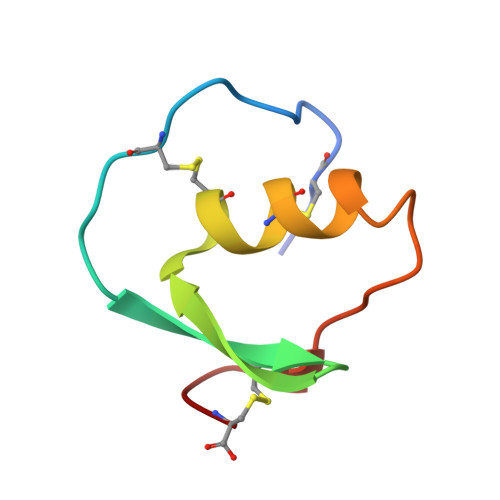Water molecules participate in proteinase-inhibitor interactions: crystal structures of Leu18, Ala18, and Gly18 variants of turkey ovomucoid inhibitor third domain complexed with Streptomyces griseus proteinase B.
Huang, K., Lu, W., Anderson, S., Laskowski Jr., M., James, M.N.(1995) Protein Sci 4: 1985-1997
- PubMed: 8535235
- DOI: https://doi.org/10.1002/pro.5560041004
- Primary Citation of Related Structures:
1SGP, 1SGQ, 1SGR, 2SGE - PubMed Abstract:
Crystal structures of the complexes of Streptomyces griseus proteinase B (SGPB) with three P1 variants of turkey ovomucoid inhibitor third domain (OMTKY3), Leu18, Ala18, and Gly18, have been determined and refined to high resolution. Comparisons among these structures and of each with native, uncomplexed SGPB reveal that each complex features a unique solvent structure in the S1 binding pocket. The number and relative positions of water molecules bound in the S1 binding pocket vary according to the size of the side chain of the P1 residue. Water molecules in the S1 binding pocket of SGPB are redistributed in response to the complex formation, probably to optimize hydrogen bonds between the enzyme and the inhibitor. There are extensive water-mediated hydrogen bonds in the interfaces of the complexes. In all complexes, Asn 36 of OMTKY3 participates in forming hydrogen bonds, via water molecules, with residues lining the S1 binding pocket of SGPB. For a homologous series of aliphatic straight side chains, Gly18, Ala18, Abu18, Ape18, and Ahp18 variants, the binding free energy is a linear function of the hydrophobic surface area buried in the interface of the corresponding complexes. The resulting constant of proportionality is 34.1 cal mol-1 A-2. These structures confirm that the binding of OMTKY3 to the preformed S1 pocket in SGPB involves no substantial structural disturbances that commonly occur in the site-directed mutagenesis studies of interior residues in other proteins, thus providing one of the most reliable assessments of the contribution of the hydrophobic effect to protein-complex stability.
Organizational Affiliation:
Department of Biochemistry, University of Alberta, Edmonton, Canada.
















